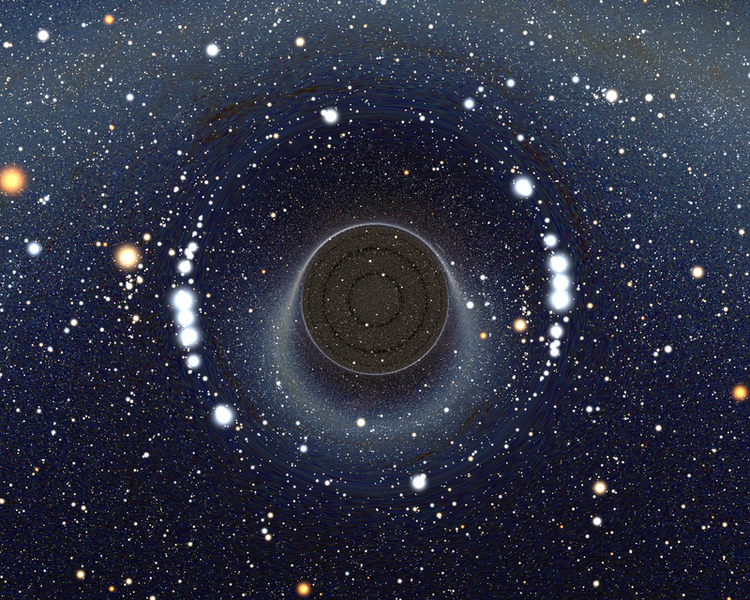
The universal speed limit, which we commonly call the speed of light, is fundamental to the way the universe works. But human imagination knows no real limits. In science fiction, you often hear about ‘wormholes’, which are objects that enable faster-than-light travel by instantaneously transferring passengers from one point in spacetime to another.
Although the General Theory of Relativity and the Standard Model of Physics can theoretically support the existence of wormholes within their frameworks, they forbid traversable wormholes.
But physicists at Princeton flexed some serious mathematical muscles and found a loophole. By exploiting quirks of quantum mechanics within a five-dimensional universe, the researchers claim that it may be possible to create a wormhole large enough for humans and their spacecraft to travel through it and instantly emerge somewhere else at the other side of the universe. Alas, such a thing likely cannot exist in nature and an artificial traversable wormhole would be impossible to create with today’s technology.
Plausible? Perhaps. Practical? Definitely not
A wormhole or a Lorentzian wormhole is a sort of theoretical ‘tunnel’ through space-time, often used as the preferred mode of interstellar travel in movies like Star Trek. The opening is a shortcut through intervening space to another location in the Universe. That seems to be in stark contrast to a black hole which is less of a tunnel and more of a meat grinder. However, some physicists claim that there are many characteristics which both black holes and wormholes share.
The existence of wormholes was first proposed by Karl Schwarzchild, whose solutions to Einstein’s field equations form the basis for the inference of black holes. Sometimes, blackholes or blackhole binary systems may form connections between different points in spacetime.
The problem is that these wormholes collapse almost immediately, which would block matter from crossing from one end to the other. All hope isn’t lost yet, though.
Juan Maldacena, the Carl P. Feinberg Professor of theoretical physics from the Institute of Advanced Study and Alexey Milekhin, a graduate student of astrophysics at Princeton University, wrote a new paper in which they discuss the conditions that may allow the existence of traversable wormholes.
In their paper, the two physicists outline some very exotic circumstances that may allow wormholes stable enough for humans to cross through. This includes the existence of negative energy, for instance.
In the theory of general relativity, we usually assume that the energy is greater than zero, at all times and everywhere in the universe. This has a very important consequence for gravity: Energy is linked to mass via the formula E=mc². So negative energy would consequently also imply negative mass. Positive masses attract each other, but with a negative mass, gravity could suddenly become a repulsive force.
Quantum theory, however, allows negative energy. According to quantum physics, it is possible to borrow energy from a vacuum at a certain location, like money from a bank. In their paper, the authors mention the Casimir Effect, in which quantum fields may produce negative energy while propagating along a closed circle.
“However, this effect is typically small because it is quantum. In our previous paper, we realized that this effect can become considerable for black holes with large magnetic charge. The new idea was to use special properties of charged massless fermions (particles like the electron but with zero mass). For a magnetically charged black hole these travel along the magnetic field lines (In a way similar to how the charged particles of the solar wind create the auroras near the polar regions of the Earth),” Maldacena and Milekhin explained to Universe Today.
These sort of wormholes would be allowed by the Standard Model of particle physics. However, they would be so tiny, not even a strand of human hair would have room to pass through. What’s more, they would only exist over equally tiny distances.
In order to support wormholes large and stable enough for humans to use, the physicists had to think outside the Standard Model box. The pair of researchers turned to the Randall-Sundrum II model, also known as the 5-dimensional warped geometry theory, which describes the universe in terms of five-dimensions.
This five-dimensional model of spacetime can enable scientists to describe physics that would normally be undetectable, allowing negative energy to exist.
The produced wormholes would look like medium-sized, charged black holes. They would be large enough for a spacecraft to travel through, however, the pilot would have to navigate very powerful tidal forces.
If the pilot could somehow navigate through this chaos, entering the wormhole would instantly propel the crew to another point in spacetime — but the instant factor is only true from the perspective of the traveler. From the perspective of an outside observer, the travel would take as much time as light would take to travel from point A to point B, which is consistent with the Theory of General Relativity.
However, it would be next to impossible for this to work. Such wormholes do not exist in nature and artificially creating them would involve engineering negative mass.
In other words, it’s unlikely that wormholes will ever become a practical means of traveling through space. Nevertheless, it’s always fascinating to hear about concepts once solely thought to be of the realm of fiction that may actually be plausible.
The paper was published in the pre-print server arXiv.






